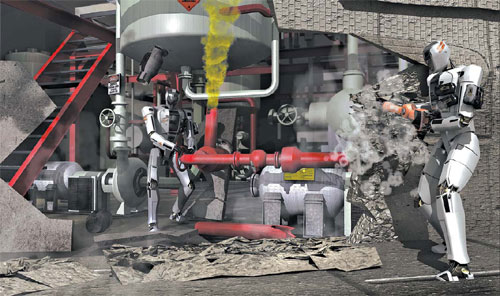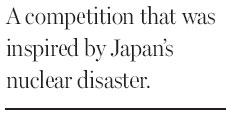Wanted: Robots for hard tasks
Updated: 2012-04-22 07:35
By John Markoff (The New York Times)
|
||||||||
|
The Pentagon is seeking ideas for robots, humanoid or otherwise, that can work in disaster zones or other places too dangerous for humans. Darpa |
In the event of another disaster at a nuclear power plant, the first responders may not be humans but robots.
The Pentagon announced a competition in early April to design specialized robots that can work in disaster zones.
And while such tasks may inspire humanoid designs, roboticists say they may also lead to the robotic equivalent of the Minotaur - a hybrid creature that might have multiple arms, and not just legs, but treads. The prize: $2 million.
Professional and amateur robot builders are buzzing about possible designs. "Analogs to animals such as spiders, monkeys, bears, kangaroos and goats are useful inspiration when considering parts of the challenge," said Aaron Edsinger, a founder of Meka Robotics in San Francisco.
The Pentagon's Defense Advanced Research and Planning Agency lists eight likely tasks the robot will need to perform - among them driving a vehicle to a simulated disaster site, removing rubble, climbing a ladder, using a tool to break through a concrete wall, finding and closing a valve on a leaking pipe, and replacing a component like a cooling pump.
Mr. Edsinger said the challenge would be to integrate them into a single mission. "I feel we already have systems that can achieve each individual task," he said.
The idea for the contest came from the Fukushima nuclear disaster in Japan a year ago, said Gill Pratt, a program manager at the agency's defense science office. "During the first 24 hours," he added, "there were things that should have been done but were not done because it was too dangerous for people to do them."
Corporate and university teams will compete to enter the robots in contests in 2013 and 2015. The robots will not need to be completely autonomous, but rather will be "supervised" by human operators, much as ground-based pilots now fly military drones.
|
|
The competition underscores the progress being made in autonomous systems in military, manufacturing and home applications. Researchers say these advances are largely a result of the falling cost of sensors, as well as developments in technologies that allow robots to move in unplanned environments.
There are already a number of ambitious humanoid robots. The Honda Asimo, which operates for a full hour on batteries, can run as fast as 9.6 kilometers an hour.
Agency officials said they were hoping for international participation in the competition. A similar proposal was made in November by Hirochika Inoue, the father of humanoid robot development in Japan.
Despite Japan's significant investment in robotics, he noted that the country did not have any robots capable of completely replacing humans at the time of the Fukushima disaster.
"We had not prepared" for such an event, he said by e-mail.
In the United States, General Motors and Boston Dynamics, a small research lab financed by the military, have developed humanoid robots. G.M.'s Robonaut 2 is on the International Space Station. Boston Dynamics, which has a transport robot and a four-legged running robot, has a humanoid robot called Atlas.
The agency will distribute a test hardware platform with legs, torso, arms and head to assist the competing teams. Mr. Pratt said his agency would also provide a software simulator to allow the widest possible participation.
"We're opening the aperture as wide as we can," he said.
The New York Times

 Relief reaches isolated village
Relief reaches isolated village
 Rainfall poses new threats to quake-hit region
Rainfall poses new threats to quake-hit region
 Funerals begin for Boston bombing victims
Funerals begin for Boston bombing victims
 Quake takeaway from China's Air Force
Quake takeaway from China's Air Force
 Obama celebrates young inventors at science fair
Obama celebrates young inventors at science fair
 Earth Day marked around the world
Earth Day marked around the world
 Volunteer team helping students find sense of normalcy
Volunteer team helping students find sense of normalcy
 Ethnic groups quick to join rescue efforts
Ethnic groups quick to join rescue efforts
Most Viewed
Editor's Picks

|

|

|

|

|

|
Today's Top News
Health new priority for quake zone
Xi meets US top military officer
Japan's boats driven out of Diaoyu
China mulls online shopping legislation
Bird flu death toll rises to 22
Putin appoints new ambassador to China
Japanese ships blocked from Diaoyu Islands
Inspired by Guan, more Chinese pick up golf
US Weekly

|

|








